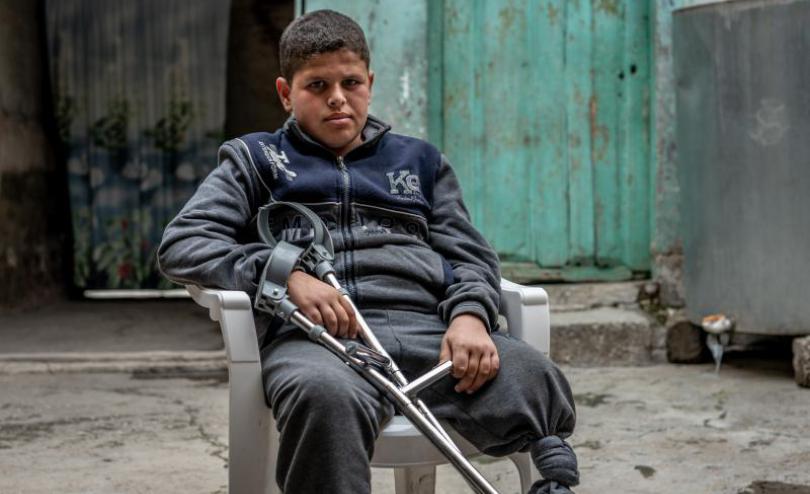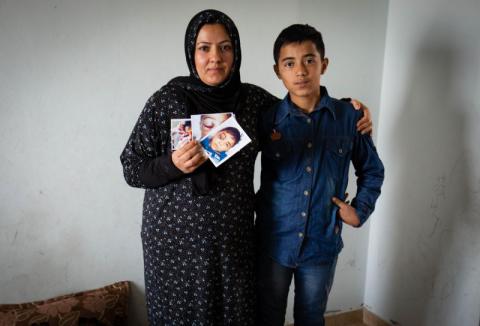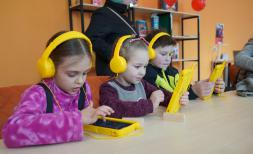Three in four child casualties in world’s deadliest conflicts caused by explosive weapons

Suicide bombs, landmines, unexploded ordinance, air strikes and other forms of explosives account for 72% of child deaths and injuries across the world’s deadliest war zones, new analysis by Save the Children reveals today[i].
The analysis shows children are uniquely and horrifically injured and impacted by explosive weapons compared to adults, and that children exposed to explosive weapons often present with symptoms of post-traumatic stress disorder (PTSD), depression, anxiety and agoraphobia[ii].
The analysis comes from UN data on the five deadliest conflicts for children - Nigeria, Afghanistan, Iraq, Syria and Yemen[iii] – as well as from a new review of child injury data, commissioned by Paediatric Blast Injury Partnership (PBIP), of which Save the Children is a co-convenor.
As a practical response, the partnership has today launched a new ground-breaking field handbook to help doctors and surgeons working with children injured by explosive weapons. The manual is a world-first guide to the unique procedures needed to keep children alive, and help them recover fully, following catastrophic injuries from explosive weapons. It also includes child specific guidance in reducing the mental trauma a child may face during injury and treatment, and coping mechanisms for children and caregivers to support their ongoing physical and mental recovery.
Save the Children’s new analysis on the impact of explosive on children further reveals today:
- In 2017 in Afghanistan, Iraq, Nigeria, Syria and Yemen 7,364 children were killed or maimed in conflict, with an estimated 5,322 of those linked to blasts[iv].
- In Afghanistan, explosive weapons were the cause of death in 84 per cent of child conflict fatalities over a two-year period, compared to 56 per cent of civilian adult deaths. Child casualties were approximately twice as likely to be killed by rockets, mortars and grenades than adult casualties.[v]
- Half of all child casualties in 2017 in Nigeria were the result of suicide attacks or IEDs[vi]
- Children’s bones bend more than those of adults, meaning a higher chance of long-term deformities as a result of blast injury. A child’s skull is also not as thick as that of an adult, meaning their risk of brain injury is higher.[vii]
- A child’s natural curiosity can put them in harm’s way. Unexploded ordnance – being small and sometimes colourful – can be easily mistaken for toys[viii].
- Children are not only at grave risk of injury or death from explosives during conflict but also in the aftermath, such as in the Ukraine where 220,000 children in the east of the country were at risk from landmines in 2017[ix].
- In some cases, children in conflict were exclusively killed by blasts, such as in 2014 in Gaza where 100% of all reported child fatalities were the result of explosive weapons[x]
- The physical toll of explosive weapons on children is coupled with a heavy psychological toll, with 84% of adults and almost all children saying that ongoing bombing and shelling was the number one cause of psychological stress in children’s daily lives[xi].
The analysis also illustrates how healthcare systems decimated by years of conflict are poorly resourced to treat ‘unique and unusual’ child blast injuries, lacking essential items like tourniquets designed for children or child-specific transfusion protocols.
A century after Save the Children was founded to protect children affected by conflict, the charity is today launching a new campaign urging world leaders to declare children off limits in war.
Major General (Ret) Michael von Bertele, former Director General of British Army Medical Services and member of the Paediatric Blast Injury Partnership (PBIP), said:
"The sad reality is most medics just haven’t been trained to treat children injured by blasts. Nearly all the textbooks and procedures we have are based on research on injured soldiers, who are usually fit adults.
“We know children’s bodies are different. They aren’t just small adults. Their skulls are still not fully formed, and their undeveloped muscles offer less protection, so a blast is more likely to damage their brain and lungs or tear apart organs in their abdomen, even when there’s no visible damage.
“And when children suffer severe injuries to their legs and arms, it takes highly specialised knowledge to know where to amputate so that you can factor in future growth. Without that, children are left with even worse disabilities, and often intractable pain for life."

Mahmoud*, 12, lives in Gaza. In 2014 when he was playing in the street, he was hit by an explosive weapon and lost his eye:
“I heard an explosion and I felt something go into my eye. I touched my eye and began to run. I felt blood pouring out.
“My eye fell out. I ran to the shop, ‘help me, help me’. They took me to the hospital, and they treated me. I woke up at the hospital. They operated on me. When I woke up from the anaesthetic, they told me that I had lost my eye.”
CEO of Save the Children International, Helle Thorning-Schmidt, said:
“International law makes clear that everyone has a responsibility to make sure children are protected in war. Yet explosive weapons continue to kill, maim and terrorise thousands of children every year. Every warring party – from armed groups to governments – must do more to protect children and abide by this important moral principle to protect children.
For those children whose lives are devastated by these weapons, this field manual is a practical tool to help doctors save more children’s lives. But ultimately, the best way of protecting children is to stop using weapons in places that should be safe, like schools and hospitals.
Too often in war today children are seeing and experiencing things that no child ever should. 2019 marks 100 years since Save the Children launched its first campaign to protect children suffering in the aftermath of the First World War, and today we are bringing leaders together at the Peace Palace in the Hague to call for urgent action to stop the war on children.”
For more information or to arrange interviews with Save the Children, please contact: media@savethechildren.org.uk or call +44 (0)20 7012 6841 / +44 (0)7831 650409 (out of hours)
Notes to editors:
- In December 2017, Save the Children and the Centre for Blast Injuries Studies based at Imperial College London convened a pioneering workshop to explore issues around paediatric blast injury. It was the first time experts from diverse fields – including surgery, paediatrics, rehabilitation, prosthetic design, and academia – were brought together to discuss blast injury in children. The workshop issued a communique that created the Paediatric Blast Injury Partnership (PBIP) to deliver practical resources and research. At the request of Syrian medics, the PBIP pooled expertise from doctors, researchers at Imperial College London, and agencies like Save the Children and Humanity & Inclusion, to develop the first comprehensive field manual for paediatric blast injury. Full production credits for the Paediatric Blast Injury Field Manual can be found here.
- In its centenary year, Save the Children is focusing on the war waged on children. The effects of conflicts are devastating: every day children are killed or maimed, abducted, recruited, sexually abused, they see their schools bombed or aid is being denied to them. In February, Save the Children revealed that some 420 million children, or one in five worldwide, are living in conflict-affected areas.
- On the anniversary of its centenary – 16 May 2019 – Save the Children is hosting an event at the Peace Palace in The Hague to alert the world on the war on children and the ways to protect children in conflict. Experts including Virginia Gamba, Michelle Bachelet and Fatou Bensouda will share their insights on how to better protect children in conflict. If your correspondent wants to join the event in The Hague, please RSVP.
- On 16 May Save the Children is also staging stunts with thousands of children around the world to stand in solidarity with children living in conflict. We invite press to come and cover the stunts. If you would like to cover the stunt, please contact Save the Children in your country.
[i] Total number of blast/non-blast related child casualties as set out in the UN CAAC report (2018). For Afghanistan, data from the CAAC Annual report was complemented with UNAMA reporting, which provided a more detailed breakdown of the same dataset. Further detail available in Save the Children’s May 2019 Report Paediatric blast injuries: the impact of explosive weapons on children in conflict.
The remaining 28% of child casualties were caused by a myriad of acts including shooting, crossfire, stabbing, gas attacks, being hit by stones, and as a result of sexual violence, indicating that children are also frequently targets of violations in conflict including killing, maiming and abuse.
[ii] Lt. JFS Millwood Hargrave,’The Impact of Blast Injury on Children: A Literature Review’, Pg 17
[iii] These were the five highest child casualty totals in the 2018 UN CAAC report
[iv] See Footnote [i]
[v] Save the Children’s analysis of United Nations Assistance Mission for Afghanistan (UNAMA) casualty logs for 2016 and 2017, the only years for which a full breakdown of causes of death is publicly available. Of 1,580 child fatalities where a cause of death was known, 1,331 (84%) deaths could be attributed to blast-related causes, 202 (13%) to non-blast causes and 47 (3%) to mixed attacks involving both explosive and non-explosive weapons. Over the same period there were 3,460 adult deaths, of which 1,948 (56%) were attributable to blast-related causes, 556 (16%) to non-blast and 956 (28%) to mixed attacks where no distinction was specified. Indirect fire systems used in ground battles, such as mortars, rockets and grenades, caused 487 (31%) child and 540 (16%) adult deaths.
[vi] See Footnote [i]
[vii] See Footnote [ii], p11.
[viii] See Footnote [ii], p11.
[ix] UNICEF, 2017. 220,000 Children Threatened by Mines and other Explosive Weapons in Eastern Ukraine. Available at: https://www.unicef.org.uk/press-releases/220000-children-threatened-mines-explosive-weapons-eastern-ukraine-unicef/
[xi] Save the Children, ‘Invisible Wounds’, 2017 p7.




